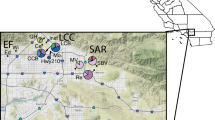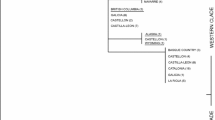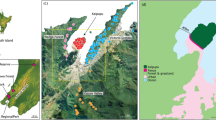Abstract
Invasive species can have complex invasion histories, harbor cryptic levels of diversity, and pose taxonomic problems for pest management authorities. Roof rats, Rattus rattus sensu lato, are common invasive pests of the San Francisco Bay Area in California, USA. They are a significant health risk and pest management efforts impose a large financial investment from public institutions and private individuals. Recent molecular genetic and taxonomic studies of black rats in their native range in Asia have shown that the species is a complex of two karyotypic forms and four mitochondrial genetic lineages that may represent four distinct species. We used mtDNA sequences and nuclear microsatellite variation to identify which mitochondrial lineages of the R. rattus group are present in the San Francisco Bay Area and to test for gene flow among them. We recovered specimens with mtDNA sequences representing two of the major mtDNA lineages of the R. rattus group. Microsatellite variation, however, was not structured in concordance with mtDNA lineages, suggesting a more complex history involving hybridization and introgression between these lineages. Although Aplin et al. (2011) and Lack et al. (2012) reported R. rattus Lineage II in North America, this is the first detailed examination of possible gene flow amongst lineages in this region.






Similar content being viewed by others
References
Abe K, Noguchi H, Tagawa K, Yuzuriha M, Toyoda A, Kojima T, Ezawa K, Saitou N, Hattori M, Sakaki Y, Moriwaki K, Shiroishi T (2004) Contribution of Asian mouse subspecies Mus musculus molossinus to genomic constitution of strain C57BL/6 J, as defined by BAC-end sequence-SKIP analysis. Genome Res 14:2439–2447
Aplin KP, Brown PR, Jacob J, Krebs C, Singleton GR (2003) Field methods for rodent studies in Asia and the Pacific. Australian Centre for International Agricultural Research, Canberra, p 223
Aplin KP, Suzuki H, Chinen AA, Chesser RT, ten Have J, Donnellan SC, Austin J, Frost A, Gonzalez JP, HerbreteauV, Catzeflis F, Soubrier J, Fang Y-P, Robins J, Matisoo-Smith E, Bastos ADS, Maryanto I, Sinaga MH, Denys C, Van Den Bussche RA, Conroy C, Rowe K, Cooper A (2011) Multiple geographic origins of commensalism and complex dispersal history of black rats. PLoS One 6(11):e26357
Atkinson IAE (1985) The spread of commensal species of Rattus to oceanic islands and their effects on island avifaunas. In: Moors PJ (ed) Conservation of island birds. ICBP Technical Publication no. 3, pp 35–81
Azad AF (1990) Epidemiology of murine typhus. Ann Rev Entomol 35:553–569
Bastos AD, Nair D, Taylor PJ, Brettschneider H, Kirsten F, Mostert E, von Maltitz E, Lamb JM, van Hoof P, Belmain SR, Contrafatto G, Downs S, Chimimba CT (2011) Genetic monitoring detects an overlooked cryptic species and reveals the diversity and distribution of three invasive Rattus congeners in South Africa. BMC Genet 12:26
Boisier P, Rahalison L, Rasolomaharo M, Ratsitorahina M, Mahafaly M, Razafimahefa M, Duplantier JM, Ratsifasoamanana L, Chanteau S (2002) Epidemiologic features of four successive annual outbreaks of bubonic plague in Mahajanga, Madagascar. Emerg Infect Dis 8:311–316
Boursot P, Auffray JC, Britton-Davidian J, Bonhomme F (1993) The evolution of house mice. Annu Rev Ecol Syst 24:119–152
Bronnenhuber J, Dufour B, Higgs D, Heath D (2011) Dispersal strategies, secondary range expansion, and invasion genetics of the non-indigenous Round goby, Neogobius melanostomus, in Great Lakes tributaries. Mol Ecol 20:1845–1859
Brooks JE (1966) Roof rats in residential areas—the ecology of invasion. Calif Vector Views 13:69–74
Brothers DR (1972) An innovation in Roof Rat control. In: Proceedings of the 5th Vertebrate Pest Conference. Fresno, p 161
Brown GG, Simpson MV (1981) Intra- and interspecific variation of the mitochondrial genome in Rattus norvegicus and Rattus rattus: restriction enzyme analysis of variant mitochondrial DNA molecules and their evolutionary relationships. Genetics 97:125–143
Chapuis MP, Estoup A (2007) Microsatellite null alleles and estimation of population differentiation. Mol Biol Evol 24:621–631
Chiba S (2010) Invasive rats alter assemblage characteristics of land snails in the Ogasawara Islands. Biol Conserv 143:1558–1563
Chinen AA, Suzuki H, Aplin KP, Tsuchiya K, Suzuki S (2005) Preliminary genetic characterization of two lineages of black rats (Rattus rattus sensu lato) in Japan, with evidence for introgression at several localities. Genes Genet Syst 80:367–375
Claffey DP, Madon MB, Smith RT (1986) An integrated pest management approach to roof rat control in oceanfront riprap, Ventura County, California. In: Salmon TP (ed) Proceedings of the 12th Vertebrate Pest Conference. University of California, Davis, p 60
Donaldson HH (1915) The rat: reference tables and data for the albino rat (Mus norvegicus albinus) and the Norway rat (Mus norvegicus). Wistar Institute, Philadelphia
Dutson VJ (1973) Use of the himalayan blackberry, Rubus discolor, by the roof rat, Rattus rattus, in California. Calif Vector Views 20:59–68
Dutson VJ (1974) The association of the roof rat (Rattus rattus) with the Himalayan Blackberry (Rubus discolor) and Algerian Ivy (Hedera canariensis) in California. In: Proceedings of the 6th Vertebrate Pest Conference, Anaheim, pp 41–48
Ecke DH (1964) Roof rat populations in Santa Clara County, California. In: Proceedings of the 2nd Vertebrate Pest Control Conference, Anaheim, p 99
Ellis BA, Regnery RL, Beati L, Bacellar F, Rood M, Glass GG, Marston E, Ksiazek TG, Jones D, Childs JE (1999) Rats of the genus Rattus are reservoir hosts for pathogenic Bartonella species: an Old World origin for a New World disease? J Infect Dis 180:220–224
Evanno G, Regnaut S, Goudet J (2005) Detecting the number of clusters of individuals using the software STRUCTURE: a simulation study. Mol Ecol 14:2611–2620
Excoffier L, Lischer HEL (2010) Arlequin suite ver 3.5: a new series of programs to perform population genetics analyses under Linux and Windows. Mol Ecol Res 10:564–567
Excoffier L, Smouse PE, Quattro JM (1992) Analysis of molecular variance inferred from metric distances among DNA haplotypes: application to human mitochondrial DNA restriction data. Genetics 131:479–491
Frazer KA, Eskin E, Kang HM, Bogue MA, Hinds DA, Beilharz EJ, Gupta RV, Montgomery J (2007) A sequence-based variation map of 8.27 million SNPs in inbred mouse strains. Nature 448:1050–1053
Gardner MB, Kozak CA, O’Brien SJ (1991) The Lake Casitas wild mouse: evolving genetic resistance to retroviral disease. TIG 7:22–27
Gomulkiewicz R, Holt RD, Barfield M, Nuismer SL (2010) Genetics, adaptation, and invasion in harsh environments. Evol Appl 3:97–108
Goodman SM (1995) Rattus on Madagascar and the dilemma of protecting the endemic rodent fauna. Conserv Biol 9:450–453
Grinnell J, Dixon J, Linsdale JM (1930) Vertebrate natural history of a section of northern California through the Lassen Peak region. UC Publ Zool 35:1–526
Gundi VAKB, Taylor C, Raoult D, La Scola B (2009) Bartonella rattaustraliani sp. nov., Bartonella queenslandensis sp. nov. and Bartonella coopersplainsensis sp. nov., identified in Australian rats. Int J Syst Evol Microbiol 59:2956–2961
Guo SW, Thompson EA (1992) Performing the exact test of Hardy-Weinberg proportion for multiple alleles. Biometrics 48:361–372
Holm S (1979) A simple sequentially rejective multiple test procedure. Scand J Stat 6:65–70
Huelsenbeck JP, Ronquist F (2001) MrBayes: Bayesian inference of phylogeny. Bioinformatics 17:754–755
International Commission on Zoological Nomenclature (1985) International code of zoological nomenclature, 4th edn. International Trust for Zoological Nomenclature
Ishizuka M, Okajima F, Tanikawa T, Min H, Tanaka KD, Sakamoto KQ, Fujita S (2007) Elevated warfarin metabolism in warfarin-resistant roof rats (Rattus rattus) in Tokyo. Drug Metab Dispos 35:62–66
Jackson WB (1982) Norway rat and allies. In: Chapman JA, Feldhamer GA (eds) Wild mammals of North America. John Hopkins University Press, Baltimore, pp 1077–1088
Jacob HJ, Brown DM, Bunker RK, Daly MJ, Dzau VJ, Goodman A, Koike G, Kren V, Kurtz T, Lernmark Å, Levan G, Mao Y-P, Pettersson A, Pravenec M, Simon JS, Szpirer C, Szpirer J, Trolliet MR, Winer ES, Lander ES (1995) A genetic linkage map of the laboratory rat, Rattus norvegicus. Nat Genet 9:63–69
Jakobsson M, Rosenberg NA (2007) CLUMPP: a cluster matching and permutation program for dealing with label switching and multimodality in analysis of population structure. Bioinformatics 23:1801–1806
Jansa SA, Barker FK, Heaney LR (2006) The pattern and timing of diversification of Philippine endemic rodents: evidence from mitochondrial and nuclear gene sequences. Syst Biol 55:73–88
Jones EP, van der Kooij J, Solheim R, Searle JB (2010) Norwegian house mice (Mus musculus musculus//domesticus): distributions, routes of colonization and patterns of hybridization. Mol Ecol 19:5252–5264
Kaleme PK, Bates JM, Belesi HK, Bowie RCK, Gambalemoke M, Kerbis-Peterhans J, Michaux J, Mwanga JM, Ndara BR, Taylor PJ, van Vuuren BJ (2011) Origin and putative colonization routes for invasive rodent taxa in the Democratic Republic of Congo. Afr Zool 46:133–145
Lack JB, Greene DU, Conroy CJ, Hamilton MJ, Braun JK, Mares MA, Van den Busche RA (2012) Invasion facilitates hybridization with introgression in the Rattus rattus species complex. Mol Ecol 21:3545–3561
Lantz DE (1909) The brown rat in the United States. US Dept Agric Biol Surv Bull 33:1–54
Lee CE (2002) Evolutionary genetics of invasive species. TREE 17:386–391
Loiseau A, Rahelinirina S, Rahalison L, Konečný A, Duplantier JM, Brouat C (2008) Isolation and characterization of microsatellites in Rattus rattus. Mol Ecol Res 8:916–918
Maddison DR, Maddison WP (2005) MacClade 4: analysis of phylogeny and character evolution. Version 4.08a. http://macclade.org
Meerburg BG, Singleton GR, Leirs H (2009) The year of the rat ends—time to fight hunger! Pest Manag Sci 65:351–352
Miller SA, Dykes DD, Polesky HF (1988) A simple salting out procedure for extracting DNA from human nucleated cells. Nucleic Acids Res 16:1215
Musser GG, Carleton MD (2005) Family Muridae. In: Wilson DE, Reeder DM (eds) Mammal species of the world: a taxonomic and geographic reference. Smithsonian Institution Press, Washington, pp 894–1531
Nolte D, Bergman D, Townsend J (2003) Roof rat invasion of an urban desert island. In: Singleton GR, Hinds LA, Krebs CJ, Spratt DM (eds) Rats, mice and people: rodent biology and management. Australian Centre for International Agricultural Research, Canberra, p 481
Nunome M, Ishimori C, Aplin KP, Yonekawa H, Moriwaki K, Suzuki H (2010) Detection of recombinant haplotypes in wild mice (Mus musculus) provides new insights into the origin of Japanese mice. Mol Ecol 19:2474–2489
Nylander JAA (2004) MrModeltest v2. Program distributed by the author. Evolutionary Biology Centre, Uppsala University
Orth A, Adama T, Din W, Bonhomme F (1998) Hybridation naturelle entre deux sous-espèces de souris domestique, Mus musculus domesticus et Mus musculus castaneus, près du lac Casitas (Californie). Genome 41:104–110
Pagès M, Chaval Y, Herbreteau V, Waengsothorn S, Cosson J-F, Hugot J-P, Morand S, Michaux J (2010) Revisiting the taxonomy of the Rattini tribe: a phylogeny-based delimitation of species boundaries. BMC Evol Biol 10:184
Peakall R, Smouse PE (2006) GENALEX 6: genetic analysis in Excel. Population genetic software for teaching and research. Mol Ecol Notes 6:288–295
Peavey C, Lane R, Kleinjan J (1997) Role of small mammals in the ecology of Borrelia burgdorferi in a peri-urban park in north coastal California. Exp Appl Acarol 21:569–584
Pelz H-J, Rost S, Hünerberg M, Fregin A, Heiberg A-C, Baert K, MacNicoll AD, Prescott CV, Walker A-S, Oldenburg J, Müller CR (2005) The genetic basis of resistance to anticoagulants in rodents. Genetics 170:1839–1847
Pennant T (1781) History of quadrupeds, vol. 2. London. Rats, p 438
Pimentel D, Zuniga R, Morrison D (2005) Update on the environmental and economic costs associated with alien-invasive species in the United States. Ecol Econ 52:273–288
Plyusnina A, Ibrahim I-N, Winoto I, Porter KR, Gotama IBI, Lundkvist A, Vaheri A, Plyusnin A (2004) Identification of Seoul Hantavirus in Rattus norvegicus in Indonesia. Scand J Infect Dis 36:356–359
Plyusnina A, Ibrahim I-N, Plyusnin A (2009) A newly recognized hantavirus in the Asian house rat (Rattus tanezumi) in Indonesia. J Gen Virol 90:205–209
Pritchard JK, Stephens M, Donnelly P (2000) Inference of population structure using multilocus genotype data. Genetics 155:945–959
Raymond M, Rousset F (1995) GENEPOP (version 1.2): population genetics software for exact tests and ecumenicism. J Hered 86:248–249
Recht MA (1988) Biology of domestic rats: telemetry yields insights for pest control. In: Crabb AC, Marsh RE (eds) Proceedings of the 13th Vertebrate Pest Conference, University of California, Davis, pp 98–100
Robins JH, Hingston J, Matisoo-Smith E, Ross HA (2007) Identifying Rattus species using mitochondrial DNA. Mol Ecol Notes 7:717–729
Rosenburg NA (2004) Distruct: a program for the graphical display of population structure. Mol Ecol Notes 4:137–138
Rost S, Fregin A, Ivaskevicius V, Conzelmann E, Hortnagel K, Pelz HJ, Lappegard K, Selfried E, Scharrer I, Tuddenham EGD et al (2004) Mutations in VKORC1 cause warfarin resistance and multiple coagulation factor deficiency type 2. Nature 427:537–541
Rowe KC, Reno ML, Richmond DM, Adkins RM, Steppan SJ (2008) Pliocene colonization and adaptive radiations in Australia and New Guinea (Sahul): multilocus systematics of the old endemic rodents (Muroidea: Murinae). Mol Phylogenet Evol 47:84–101
Rozas J, Sánchez-Delbarrio JC, Messeguer X, Rozas R (2003) DnaSP, DNA polymorphism analyses by the coalescent and other methods. Bioinformatics 19:2496–2497
Sakai T, Kikkawa Y, Miura I, Inoue T, Moriwaki K, Shiroishi T, Satta Y, Takahata N, Yonekawa H (2005) Origins of mouse inbred strains deduced from whole-genome scanning by polymorphic microsatellite loci. Mamm Genome 16:11–19
Schuelke M (2000) An economic method for the fluorescent labeling of PCR fragments. Nat Biotechnol 18:233–234
Scott S, Duncan CJ (2001) Biology of plagues: evidence from historical populations. Cambridge University Press, Cambridge
Silver J (1927) The introduction and spread of house rats in the United States. J Mammal 8:58–60
Smith KF, Carpenter SM (2006) Spread of exotic black rat (Rattus rattus) parasites to endemic deer mice (Peromyscus maniculatus) on the California Channel Islands. Divers Distrib 12:742–748
Stamatakis A (2006) RAxML-VI-HPC: maximum likelihood-based phylogenetic analyses with thousands of taxa and mixed models. Bioinformatics 22:2688–2690
Stroud DC (1982) Dynamics of Rattus rattus and R. norvegicus in a riparian habitat. J Mammal 63:154–155
Suzuki H, Tsuchiya K, Takezaki N (2000) A molecular phylogenetic framework for the Ryukyu endemic rodents Tokudaia osimensis and Diplothrix legata. Mol Phylogenet Evol 15:15–24
Swofford DL (2002) PAUP*. Phylogenetic analysis using parsimony (*and other methods). Sinauer Associates, Sunderland
Thiemann TC, Lemenager DA, Kluh S, Carroll BD, Lothrop HD, Reisen WK (2012) Spatial variation in host feeding patterns of Culex tarsalis and the Culex pipiens complex (Diptera: Culicidae) in California. J Med Entomol 49:903–916
Tollenaere C, Brouat C, Duplantier JM et al (2010) Phylogeography of the introduced species Rattus rattus in the western Indian Ocean, with special emphasis on the colonization history of Madagascar. J Biogeogr 37:398–410
Towns DR, Atkinson IAE, Daugherty CH (2006) Have the harmful effects of introduced rats on islands been exaggerated? Biol Invasions 8:863–891
Truong TT, Yoshimatsu K, Araki K, Lee BH, Nakamura I, Endo R, Shimizu K, Yasuda SP, Koma T, Taruishi M, Okumura M, Truong UN, Arikawa J (2009) Molecular epidemiological and serological studies of hantavirus infection in northern Vietnam. J Vet Med Sci 71:1357–1363
Weir BS, Cockerham CC (1984) Estimating F-Statistics for the analysis of population structure. Evolution 38:1358–1370
Wilgenbusch JC, Warren DL, Swofford DL (2004) AWTY: a system for graphical exploration of MCMC convergence in Bayesian phylogenetic inference, http://king2.scs.fsu.edu/CEBProjects/awty/awty_start.php
Wolfs TFW, Wagenaar JA, Niesters HGM, Osterhaus ADME (2002) Rat-to-human transmission of cowpox infection. Emerg Infect Dis 8:1495–1496
Yonekawa H, Tsuda K, Tsuchiya K, Yakimenko L, Korobitsyna K, Chelomina GN, Spiridonova LN, Frisman L, Kryukov A, Moriwaki K (2003) Genetic diversity, geographic distribution and evolutionary relationships of Mus musculus subspecies based on polymorphisms of mitochondrial DNA. In: Kryukov A, Yakimenko L (eds) Problems of evolution, vol. 5 Vladivostok, Dalnauka, pp 90–108
Yosida TH (1980) Cytogenetics of the black rat: karyotype evolution and species differentiation. University of Tokyo Press, Tokyo
Yosida TH, Kato H, Tsuchiya K, Moriwaki K (1971) Karyotype and serum transferrin patterns of hybrids between Asian and Oceanian black rats, Rattus rattus. Chromosoma 34:40–50
Zeiner DC, Laudenslayer WF Jr, Meyer KE, White M, (eds) (1990) California’s Wildlife. Volume III: Mammals. State of California. The Resources Agency, Sacramento
Acknowledgments
This work benefitted from support from Denise Bonilla of the California Department of Public Health, and fieldwork by Tia Reddick, an intern with the Alameda County Vector Control District. Michael Kosoy (CDC) tested tissues for Bartonella strains, and Robert Lane (UC Berkeley) tested tissues for Borrelia. Cherilyn Acorda conducted some of the early laboratory work. This work was improved by discussions with Steve Donnellan, Ron Van Den Bussche, Hitoshi Suzuki, Jean-François Cosson and others at the first R. rattus consortium meeting in Bangkok in 2010. Thanks to curators and collection managers Joseph Cook and Jon Dunnum (Museum of Southwestern Biology), Larry Heaney, Bruce Patterson and Bill Stanley (Field Museum of Natural History) for access to worldwide samples of Rattus tissues. This work would not have been possible without those loans. Many thanks to Anita Pearson who personally donated many of the rats included here, especially where Lineages I and II are sympatric. Funding for laboratory analyses was kindly provided by the MVZ, and the Alameda County Vector Control District directly funded PK.
Author information
Authors and Affiliations
Corresponding author
Electronic supplementary material
Below is the link to the electronic supplementary material.
10530_2012_323_MOESM1_ESM.eps
Supplementary material 1 (EPS 8457 kb) Fig. S1. Plot of number of inferred genetic clusters (K) versus ∆K (the rate of change in the log probability of the data between successive K values) based on the Evanno et al. (2005) method, for (A) within the SF Bay Area and (B) among all populations sample
Rights and permissions
About this article
Cite this article
Conroy, C.J., Rowe, K.C., Rowe, K.M.C. et al. Cryptic genetic diversity in Rattus of the San Francisco Bay region, California. Biol Invasions 15, 741–758 (2013). https://doi.org/10.1007/s10530-012-0323-9
Received:
Accepted:
Published:
Issue Date:
DOI: https://doi.org/10.1007/s10530-012-0323-9




